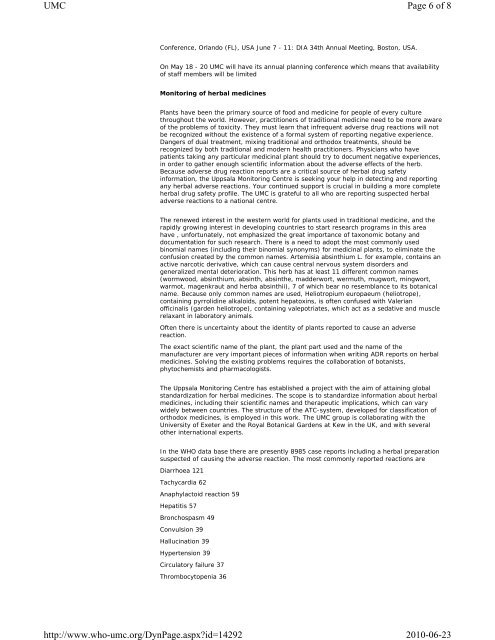March 1998 - Uppsala Monitoring Centre
March 1998 - Uppsala Monitoring Centre
March 1998 - Uppsala Monitoring Centre
Create successful ePaper yourself
Turn your PDF publications into a flip-book with our unique Google optimized e-Paper software.
UMChttp://www.who-umc.org/DynPage.aspx?id=14292Page 6 of 82010-06-23Conference, Orlando (FL), USA June 7 - 11: DIA 34th Annual Meeting, Boston, USA.On May 18 - 20 UMC will have its annual planning conference which means that availabilityof staff members will be limited<strong>Monitoring</strong> of herbal medicinesPlants have been the primary source of food and medicine for people of every culturethroughout the world. However, practitioners of traditional medicine need to be more awareof the problems of toxicity. They must learn that infrequent adverse drug reactions will notbe recognized without the existence of a formal system of reporting negative experience.Dangers of dual treatment, mixing traditional and orthodox treatments, should berecognized by both traditional and modern health practitioners. Physicians who havepatients taking any particular medicinal plant should try to document negative experiences,in order to gather enough scientific information about the adverse effects of the herb.Because adverse drug reaction reports are a critical source of herbal drug safetyinformation, the <strong>Uppsala</strong> <strong>Monitoring</strong> <strong>Centre</strong> is seeking your help in detecting and reportingany herbal adverse reactions. Your continued support is crucial in building a more completeherbal drug safety profile. The UMC is grateful to all who are reporting suspected herbaladverse reactions to a national centre.The renewed interest in the western world for plants used in traditional medicine, and therapidly growing interest in developing countries to start research programs in this areahave , unfortunately, not emphasized the great importance of taxonomic botany anddocumentation for such research. There is a need to adopt the most commonly usedbinomial names (including their binomial synonyms) for medicinal plants, to eliminate theconfusion created by the common names. Artemisia absinthium L. for example, contains anactive narcotic derivative, which can cause central nervous system disorders andgeneralized mental deterioration. This herb has at least 11 different common names(wormwood, absinthium, absinth, absinthe, madderwort, wermuth, mugwort, mingwort,warmot, magenkraut and herba absinthii), 7 of which bear no resemblance to its botanicalname. Because only common names are used, Heliotropium europaeum (heliotrope),containing pyrrolidine alkaloids, potent hepatoxins, is often confused with Valerianofficinalis (garden heliotrope), containing valepotriates, which act as a sedative and musclerelaxant in laboratory animals.Often there is uncertainty about the identity of plants reported to cause an adversereaction.The exact scientific name of the plant, the plant part used and the name of themanufacturer are very important pieces of information when writing ADR reports on herbalmedicines. Solving the existing problems requires the collaboration of botanists,phytochemists and pharmacologists.The <strong>Uppsala</strong> <strong>Monitoring</strong> <strong>Centre</strong> has established a project with the aim of attaining globalstandardization for herbal medicines. The scope is to standardize information about herbalmedicines, including their scientific names and therapeutic implications, which can varywidely between countries. The structure of the ATC-system, developed for classification oforthodox medicines, is employed in this work. The UMC group is collaborating with theUniversity of Exeter and the Royal Botanical Gardens at Kew in the UK, and with severalother international experts.In the WHO data base there are presently 8985 case reports including a herbal preparationsuspected of causing the adverse reaction. The most commonly reported reactions areDiarrhoea 121Tachycardia 62Anaphylactoid reaction 59Hepatitis 57Bronchospasm 49Convulsion 39Hallucination 39Hypertension 39Circulatory failure 37Thrombocytopenia 36
















